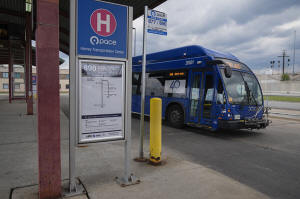Chicago risks severe cuts to transit. Its poorest suburbs could be hit
even harder
[May 30, 2025]
By JEFF McMURRAY
HARVEY, Ill. (AP) — Winfred Wilson was struggling to make ends meet on
less than $700 a month, so he moved in with his daughter, gave up his
car and started relying exclusively on public transit to take him
wherever he needed to go across Chicago's southern suburbs.
As he waited for a bus connection in his hometown of Harvey on a recent
trip to the grocery store, Wilson waved at familiar travelers who
regularly pass through the key transportation hub serving one of the
region's poorest areas. Many, he said, encounter little resistance from
drivers when they board without paying.
“People in affluent neighborhoods, they have cars and personal
transportation, but they don’t want to get caught up in the rush hour,”
so they use transit, Wilson said. “We couldn't live without it.”
Public transit agencies across the U.S. have been grappling with a
fiscal cliff spurred by declining ridership and the impending sunset of
federal COVID-19 relief funding. The Chicago area faces particularly
bleak service cuts that officials warn could be set in motion as early
as Saturday if Illinois legislators adjourn without plugging a $770
million hole in the transportation budget.
The big city's commuters would be hit hard, with the Chicago Transit
Authority poised to shut down four of eight elevated train lines and 74
of 127 bus routes under the worst-case scenario. But perhaps no place
illustrates the range of potential outcomes more vividly than Harvey,
whose mayor, Christopher Clark — a lifelong resident — says was once
“the metropolis of the Southland” before plants and factories closed and
disinvestment took hold.

Suburb at a crossroads
Already the busiest station for PACE, the region's suburban bus system
that also serves paratransit customers, Harvey recently won state and
federal grant money for a state-of-the-art facility that would put the
buses under the same roof as the Metra commuter rail stop a block away.
Plans eventually call for a high-speed bus line connecting the Harvey
station to the Red Line L train that cuts through the downtown Chicago
Loop.
Such an upgrade could be an economic boon for Harvey, where now-vacant
businesses are found on almost every downtown block and where more than
1 in 4 residents live below the poverty line. But even if the new
station is built, ending or severely cutting the buses and trains that
pass through could send the city reeling in the opposite direction.
“It would be chaos for us in the suburbs,” said Cheyane Felton, after
finishing her shift at a coffee stand in the basement of Harvey's City
Hall. “It would cut us off.”
Without additional state funding, PACE could be forced to halt buses in
Harvey and elsewhere on weekends and after 8 p.m. on weekdays, executive
director Melinda Metzger said.
“The downside for this is disastrous,” she said in an interview at the
Harvey stop. “You would be cutting back your service by at least 40%,
not giving people viable rides. They might get to work, but they might
have a late-night shift and can’t get home, so ridership also would
plummet to match the service cuts.”
Transit's nationwide funding crunch
Major public transportation agencies across the country have had varying
degrees of success lobbying their legislatures for more support with the
federal emergency funding set to expire at the end of the year.

[to top of second column]
|

A bus leaves the Pace Harvey Transportation Center, Thursday, May
29, 2025, in Harvey, Ill. (AP Photo/Erin Hooley)

Perhaps no place mirrors Chicago's current situation more than
Philadelphia, which faces a $213 million transportation budget
deficit next year, even after Pennsylvania Gov. Josh Shapiro
authorized redirecting some of the state's highway money to mass
transit. Absent more funding, riders could see a 20% spike in fares,
a 9 p.m. curfew, and the elimination of 50 bus routes and five of
eight regional rail lines, the Southeastern Pennsylvania
Transportation Authority has said.
New York Gov. Kathy Hochul signed a bailout package in 2023 to help
fund New York City’s subway and buses. She also opened a major new
source of transit revenue by implementing congestion pricing for
drivers in Manhattan, but it remains to be seen whether the new
tolls will survive threats from President Donald Trump’s
administration to shut them down.
Boston, San Francisco, Washington, D.C., and numerous other
transit-dependent cities have also been scrambling to avert major
cuts.
A moving deadline?
“No funding without reform” has been a common mantra among Illinois
legislators working to hash out a solution for Chicago's transit
crisis before leaving Springfield on Saturday at the end of their
regular session.
Technically, the money doesn't run out until the end of the year,
and there will likely be a veto session that could provide another
shot at an 11th-hour rescue. But transportation officials say
they'll have to start laying out the specific cuts next week if the
funding doesn't come through by then.
“It’s not a light switch we can just turn on or off," said Leanne
Redden, executive director of the Regional Transportation Authority,
which oversees planning and funding for the area's transit agencies.
"Even if we find funding at a future point, it’s a slow process to
kind of unwind the unwinding.”
So far, there have been no major breakthroughs on funding, although
a compromise surfaced this week to create a new umbrella
organization that, among other things, would ensure the various
agencies work in unison rather than as competitors for the same
customers.

“They should just be able to get on and go where they want to go,
and that has not been happening with the governance that we’ve had
up to now,” Gov. J.B. Pritzker said.
Chicago's transit agencies argue they’re more efficient than their
peers in other states and get by with a smaller portion of state
funding.
Clark, the Harvey mayor, said he still envisions his community
benefitting from the economic promise of a new transit facility
rather than enduring disappointment once again.
“I guess some people want me to paint a picture that it’s a nuclear
Armageddon or something like that,” he said. “I can't paint that
picture because I have to remain ever hopeful that we will get what
we need to get in due time. Government is a long game.”
All contents © copyright 2025 Associated Press. All rights reserved |